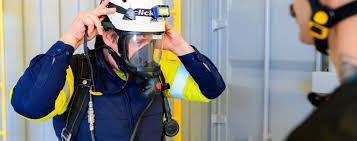Understanding SBAS: How They Work and When to Use Them
Self-Contained Breathing Apparatus (SCBA), often referred to as Safety Breathing Apparatus (SBA) or simply SBAS, are essential pieces of safety equipment designed to provide breathable air in hazardous environments. Unlike simple respirators that filter contaminants from the surrounding air, SBAS provides a completely independent air supply, making them crucial in situations where the atmosphere is immediately dangerous to life or health (IDLH). This article delves into the mechanics of safety breathing apparatus, explores their various applications, and highlights their importance in conjunction with other safety measures like Life Rafts.
The Mechanics of SBAS
SBAS units are complex systems designed for reliability and
user safety. They generally consist of four main components:
- Cylinder: This stores the compressed breathing air, typically at
high pressures (e.g., 2216 or 4500 psi). Cylinders are made of lightweight
yet durable materials like aluminum, steel, or composite materials wrapped
with fiberglass or carbon fiber.
- Regulator: This crucial component reduces the high pressure from
the cylinder to a usable breathing pressure for the user. It typically
involves a two-stage reduction process: a primary stage that reduces the
pressure to an intermediate level and a secondary stage that further reduces
it to a pressure slightly above atmospheric pressure.
- Facepiece: This creates a tight seal around the user's face,
preventing contaminated air from entering. It includes an exhalation valve
to expel exhaled air and a connection point for the breathing hose.
- Harness
and Backplate: This assembly securely holds
the cylinder and other components on the user's back, distributing the
weight evenly and allowing for freedom of movement.
The operation of an SBAS is relatively straightforward. The
user dons the harness and facepiece, ensuring a proper seal. When the cylinder
valve is opened, air flows through the regulator, which reduces the pressure to
a breathable level. The user inhales air from the facepiece, and exhaled air is
expelled through the exhalation valve.
Types of SBAS
There are two primary types of SBAS:
- Open-Circuit
SBAS: This is the most common type.
Exhaled air is vented directly into the surrounding atmosphere. These are
simpler in design and generally lighter than closed-circuit systems.
- Closed-Circuit
SBAS: Also known as rebreathers,
these systems recycle the user's exhaled air. Carbon dioxide is removed,
and oxygen is replenished, allowing for longer use times. These are
typically used in specialized applications like mine rescue or extended underwater
operations.
When to Use SBAS?
SBAS are essential in a variety of hazardous environments
where the air is contaminated, oxygen-deficient, or immediately dangerous to
life or health. Some common applications include:
- Firefighting: SBAS are crucial for firefighters entering burning
buildings where smoke, toxic gases, and oxygen deficiency pose significant
threats.
- Industrial
Settings: Workers in chemical plants,
refineries, and other industrial facilities may need SBAS when working
with hazardous materials or in confined spaces with potentially dangerous
atmospheres.
- Hazardous
Materials Response:
Emergency responders dealing with chemical spills or other hazardous
materials incidents rely on SBAS for respiratory protection.
- Confined
Space Entry: Workers entering confined
spaces such as tanks, silos, or pipelines often require SBAS due to the
potential for oxygen deficiency or the presence of toxic gases.
- Marine
Emergencies and Life Rafts:
While not directly used in a life raft, SBAS can be crucial during
the initial stages of a marine emergency. For instance, if a fire breaks
out on a vessel, crew members may need SBAS to safely reach the life raft
deployment area. In situations involving toxic fumes or smoke during
evacuation, SBAS provides crucial protection.
SBAS and Life Rafts: A Combined Safety Approach
While SBAS protects individuals from immediate respiratory
hazards, Life Rafts provide a means of escape and survival in maritime
emergencies. These two pieces of safety equipment complement each other in
ensuring overall safety. In a maritime emergency where a vessel must be
abandoned, SBAS can provide the necessary respiratory protection to safely
reach and deploy life rafts, especially in situations involving smoke, fire, or
hazardous cargo. Once aboard the life raft, other survival equipment takes
precedence.
Training and Maintenance
Proper training is crucial for the safe and effective use of
SBAS. Users must be trained on how to don and doff the equipment, perform
pre-use checks, understand the limitations of the equipment, and recognize
warning signs of malfunction. Regular maintenance, including inspections,
cleaning, and testing, is also essential to ensure the SBAS remains in good
working condition.
Conclusion
SBAS are vital pieces of safety equipment that provide breathable air in hazardous environments. Understanding how they work, when to use them, and the importance of proper training and maintenance is crucial for ensuring the safety of individuals working in or responding to dangerous situations. Combining SBAS with other safety measures like Life Rafts creates a comprehensive approach to safety in various scenarios, particularly in maritime emergencies. The proper use and maintenance of SBAS can be the difference between life and death in hazardous atmospheres.
.jpg)
Comments
Post a Comment